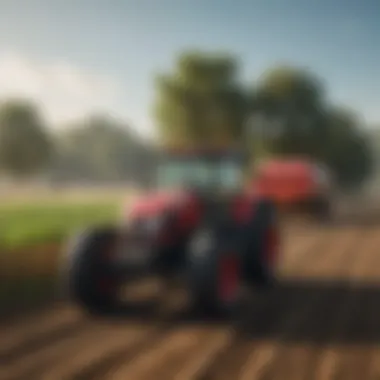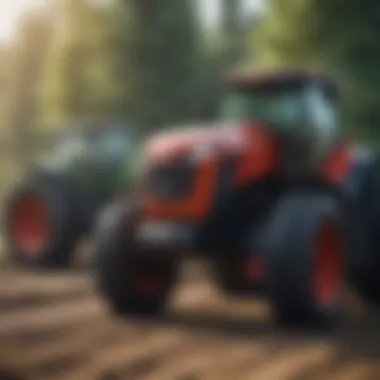Exploring Auto Steering Tractors: Innovations in Precision Agriculture


Intro
In today's agricultural landscape, the role of technology has become paramount. Among various innovations, auto steering tractors stand out by revolutionizing how farmers approach their work. This technology focuses on enhancing precision, which not only improves productivity but also contributes to sustainable farming practices.
The significance of auto steering tractors cannot be overstated. They enable farmers to operate machinery with superior accuracy, optimizing field operations. This does not only translate into better crop yields but also helps in conserving resources like fuel and fertilizers, aligning with modern sustainability goals.
Topic Overview
Definition and Importance
Auto steering tractors utilize advanced GPS and sensor technologies to guide machinery autonomously across fields. This means that the tractors can maintain precise alignment, making it easier to carry out tasks such as planting, fertilizing, and harvesting. The importance of this technology lies in its ability to minimize human error while maximizing efficiency.
Brief History and Evolution
The evolution of auto steering technology can be traced back to the early 2000s when GPS technology began to gain traction in agriculture. Initially, it was used for mapping fields and tracking equipment. As the technology progressed, more sophisticated systems emerged. Today’s systems integrate real-time data analysis and automation, providing farmers with tools that were unimaginable just a few decades ago.
"The adoption of auto steering technology is not just an upgrade but a necessary step in the evolution of agriculture towards greater precision and sustainability."
Key Techniques and Innovations
Sustainable Farming Practices
Auto steering tractors play a crucial role in sustainable farming. They help farmers reduce overlap during field operations, ensuring that every seed planted, every pound of fertilizer used, and every drop of pesticide applied is done efficiently. Thus, farmers can significantly decrease resource wastage while promoting healthier crops and soil.
Advanced Agronomic Technologies
Besides basic steering functions, recent advancements include integration with other precision farming technologies such as yield monitoring and soil mapping. These innovations aid in making informed decisions. Farmers can analyze data from various sources to tailor their operations to the specific needs of their crops and soil conditions, leading to improved resource management and increased productivity.
Practical Applications
Step-by-Step Guides
To get started with auto steering tractors, farmers can follow these general steps:
- Choose the Right System: Assess your farming needs to select a system that suits your operations.
- Installation: Work with professionals, if necessary, to install the equipment properly on your tractor.
- Calibration: Ensure that the system is correctly calibrated to your field size and type of crops.
- Testing: Conduct test runs to familiarize yourself with the operation and make adjustments as needed.
Case Studies or Real-World Examples
Several farms around the world have adopted auto steering technology with impressive results. A notable example is a vineyard in California that implemented this technology. By using auto steering tractors, they reported a significant decrease in pesticide use while maintaining high-quality grape production. Additionally, farmers in Iowa have achieved increased efficiency in planting schedules, leading to extraordinary yield improvements.
Prelude to Auto Steering Tractors
The introduction of auto steering tractors represents a significant shift in agricultural practices. This technology allows for enhanced precision and efficiency, which are critical in modern farming operations. Farmers are continually looking for ways to improve productivity while conserving resources. Auto steering tractors facilitate this by enabling more accurate navigation in the fields.
Precision agriculture relies on various technologies, and auto steering is one of the most prominent. By using GPS and advanced sensors, farmers can achieve exact row spacing, optimal planting depth, and minimized overlaps during field operations. This leads to better yield and reduced waste.
Moreover, the benefits extend beyond just precision. Auto steering systems can decrease the physical strain on operators, allowing for longer working hours without the same level of fatigue. This is crucial during peak farming seasons when timely interventions can significantly impact the harvest.
Defining Auto Steering Technology
Auto steering technology refers to the mechanized systems that guide tractors through fields with minimal manual input. The core of this technology often includes GPS systems that track the vehicle's location with incredible accuracy. Additionally, these systems may incorporate various sensors to monitor the tractor's position and alignment relative to pre-defined paths.
This technology operates through control algorithms that assess real-time data from the GPS and sensors. The tractor autonomously adjusts its steering to maintain a straight line or follow a specified path. Operators can set the desired route before commencement, allowing them to focus on other tasks while the tractor operates.
In an increasingly competitive agricultural landscape, the precision offered by auto steering technology is not just a luxury but a necessity. It ensures that every inch of farmland is utilized effectively, leading to higher productivity levels.


Historical Background
The concept of auto steering in agriculture is not entirely new. The evolution began with the introduction of mechanical devices designed to assist farmers in guiding their tractors. Early systems relied on simple mechanical linkages that helped maintain straight paths. However, these systems were limited in accuracy and effectiveness.
The significant turning point came with the advent of GPS technology. In the late 1990s, GPS became accessible to farmers, enabling them to use advanced navigation systems in their equipment. This marked the beginning of modern auto steering systems. The integration of satellite technology allowed for real-time tracking, leading to much more accurate navigation and greatly reducing the gaps and overlaps in field work.
By the early 2000s, manufacturers like John Deere and Trimble had developed advanced automatic steering solutions. These systems laid the groundwork for future innovations, increasing user acceptance and demonstrating clear results in yield and efficiency improvements.
Today, auto steering tractors are a staple on many farms globally, showcasing how far agricultural technology has come. With continual advancements in technology and focus on sustainability, the future of auto steering tractors looks promising.
Key Components of Auto Steering Tractors
Auto steering tractors represent a significant leap forward in the world of precision agriculture. The efficiency of these systems heavily relies on several key components that work in harmony. This section will specifically discuss the vital roles of GPS systems, sensors and cameras, and control algorithms, highlighting how these elements contribute to both the performance of auto steering tractors and the broader goals of modern farming.
GPS Systems
Global Positioning System (GPS) technology is a cornerstone of auto steering systems. GPS allows tractors to accurately determine their location in relation to the farm layout. This spatial awareness is crucial for maintaining straight, precise lines during farming tasks. Enhanced GPS signals enable auto steering tractors to achieve centimeter-level accuracy, which optimizes field operations.
Farmers benefit from this precision since it minimizes overlap and gaps in field work. Better accuracy translates directly to increased crop yields and reduction in wasted inputs. For instance, in the planting phase, correct spacing can significantly improve crop density and health. Moreover, GPS technology can also be integrated with geographical information systems (GIS) to provide deeper insights into soil health and productivity.
Sensors and Cameras
Sensors and cameras are critical for real-time data collection and monitoring during agricultural operations. These devices help to assess environmental conditions and the status of crops and soil. Various types of sensors are employed, including ultrasonic sensors for distance measurement and infrared cameras for monitoring plant health.
The data gathered by sensors enhances the tractor’s ability to adapt to changing conditions. For example, moisture sensors can inform the tractor when to adjust its operations in response to soil moisture levels. This leads to better resource management, as water and fertilizers can be applied only where and when they are needed. Furthermore, the integration of cameras allows for visual assessments that can guide decision-making on-the-go. All this improves operational efficiencies and sustainability efforts.
Control Algorithms
Control algorithms, which are software that interprets data from GPS, sensors, and cameras, constitute the brain of the auto steering system. These algorithms process data in real time to make instant adjustments for steering, speed, and operational methods. The sophisticated algorithms ensure that the tractor maintains its intended path, even in the face of external challenges such as uneven terrain or sudden obstacles.
An important aspect of control algorithms is their ability to learn from previous operations. This adaptive learning capability helps optimize future tasks, as the system can leverage past experiences to make informed decisions. The impact of effective control algorithms is significant. They enhance the precision of agricultural practices and contribute to a more systematic approach to farming operations, allowing farmers to focus on strategic decisions while the tractor handles the precise driving tasks.
"The integration of GPS, sensors, and control algorithms is revolutionary, transforming conventional farming into an automated science."
Understanding these key components not only highlights their importance but also sets the stage for comprehending the broader implications of auto steering tractors in agriculture. By leveraging technology effectively, modern farmers can achieve more efficient, sustainable practices.
Benefits of Auto Steering Technology
Auto steering technology has ushered in a new era in precision agriculture. This technology enhances many aspects of farming, making it a vital topic for farmers and agricultural enthusiasts to understand. There are several key elements to consider when evaluating the benefits of this innovation. It not only improves accuracy in fieldwork but also enriches the overall Farming experience.
Increased Precision in Farming
One of the primary advantages of auto steering technology is the significant increase in precision in farming practices. When tractors implement auto steering, the systems rely on GPS and advanced algorithms to guide movements. This means farmers can achieve sub-inch accuracy in their field operations.
With this precision, there is less overlap and misses during tasks such as planting, spraying, and harvesting. This accuracy leads to better seed placement, consistent row spacing, and uniform crop growth. Consequently, crop yields see substantial improvement due to optimized growth conditions, ultimately benefitting farmers’ bottom lines.
Improved Efficiency
Efficiency is another area profoundly impacted by auto steering technology. Farmers face immense time pressures, especially during critical phases of planting and harvesting. The use of auto steering permits continuous operation without requiring constant manual adjustments. This means that farmers can work for longer hours without fatigue.
By reducing the number of passes required in the field, the tractors save both time and fuel. Efficient use of machinery enables farmers to allocate other resources better, enhancing overall farm management. As a result, the implementation of auto steering can lead to significant cost savings over time, facilitating reinvestment in farming operations.
Reduction in Resource Use
The adoption of auto steering technology also plays a key role in resource conservation. One of the core benefits is the reduction in inputs like seeds, fertilizers, and pesticides. Accurate application rates help avoid over-application, leading to less waste. As the machinery covers the field efficiently, there is a marked reduction in soil compaction, which promotes healthier soil structure.
In terms of environmental impact, fewer chemical inputs mean less runoff and reduced impact on surrounding ecosystems. Overall, auto steering tractors align with sustainable farming practices, enabling farmers to protect resources while improving yield potential.


"The integration of auto steering technology not only advances farming efficiency but also promotes environmental stewardship."
Challenges in Implementing Auto Steering Tractors
The integration of auto steering technology in tractors presents several challenges that need attention. Understanding these challenges is crucial to maximizing the benefits of this advancement in precision agriculture. Farmers and industry stakeholders must navigate costs, training, and technical constraints to effectively adopt this technology.
Cost Considerations
One of the primary challenges in implementing auto steering tractors is the cost associated with the technology. The initial investment for acquiring the necessary equipment can be significant. Items such as GPS systems, sensors, and control modules can add up quickly. Furthermore, these systems may require ongoing maintenance and software updates, contributing to long-term expenses. Farmers must evaluate their budget and decide if the potential efficiency gains justify the costs.
"Investing in auto steering technology often feels like a leap of faith for many farmers; financial viability is a central concern."
It's not just about purchasing the equipment. There may also be costs related to retrofitting existing tractors, which can deter some from transitioning to this emerging technology. Farmers frequently seek financing options or government incentives to alleviate these financial burdens.
Training Requirements for Operators
Alongside cost concerns, training requirements for operators present another significant hurdle. Auto steering systems, while designed to simplify tasks, require specific knowledge to operate effectively. Farmers and their workers must learn how to set the equipment, monitor performance, and troubleshoot issues that may arise.
Training can often be resource-intensive, requiring time away from regular farming duties. Some may find the learning curve steep, especially for those who are not tech-savvy. Effective training programs need to be accessible to ensure all operators can confidently manage the equipment.
Maintaining a skilled workforce is key. Hence, agri-tech companies might collaborate with educational institutions to develop instructional programs. This helps to foster a culture of understanding and support in utilizing advanced technology on the farm.
Technical Limitations
The final challenge revolves around technical limitations of current auto steering systems. While advancements have greatly improved functionality, no system is without its flaws. Issues can arise, such as signal loss due to poor satellite positioning or environmental conditions. Auto steering relies heavily on GPS data; any interruption could lead to inefficiencies or costly mistakes.
Moreover, compatibility between different systems and tractor models can limit flexibility. Farmers often have a mix of equipment, and ensuring seamless integration can be complex.
It's important to address these technical constraints continually. Research and development efforts from manufacturers can enhance the reliability of these systems. Collaboration between industry players and innovation hubs can lead to developing solutions that mitigate these challenges.
In summary, while auto steering technology offers many advantages, stakeholders must confront significant challenges when implementing it. Addressing cost considerations, ensuring adequate training, and overcoming technical limitations are all essential for successful adoption.
Applications of Auto Steering Tractors
The applications of auto steering tractors in modern agriculture are extensive and transformative. This technology not only enhances productivity but also minimizes environmental impact, which is crucial as farmers face increasing demands for sustainable practices. From field preparation to harvesting, each application highlights the integration of auto steering technology into the farming lifecycle.
Field Preparation
In field preparation, auto steering tractors play a vital role in optimizing the layout of the land. Precision in tractor guidance leads to uniform tillage and soil cultivation. Traditionally, farmers faced challenges such as uneven compaction and inefficient use of time. With auto steering, these issues are significantly reduced.
The GPS systems and sensors on board enable tractors to follow exact paths. This results in consistent depth during plowing and prevents overlap in work, which can lead to unnecessary wear on machinery and soil compaction. As a result, the groundwork lays a healthy foundation for crops to thrive.
Planting and Cultivating
The process of planting and cultivating benefits immensely from auto steering tractors. These machines provide precise control over seed placement, which is essential for optimizing plant growth. Properly spaced seeds lead to better resource utilization, resulting in improved yields. Farmers can adjust their equipment settings to fit the specific crops being planted, ensuring optimal planting depth and seed coverage.
Moreover, the ability to cultivate fields with consistent accuracy reduces competition among plants for nutrients and sunlight. This increases overall crop health and yields. The meticulous calibration done by auto steering systems helps in applying inputs efficiently during cultivation, thus ensuring that plants receive the necessary nutrients without excess runoff.
Harvesting
During harvesting, auto steering tractors contribute to a smoother and more efficient process. Harvesting requires timely execution to prevent crop losses, and precision-guided tractors make it easier to cover fields evenly. This technology allows operators to focus on monitoring machinery performance and adjusting speeds as needed, rather than constantly correcting the vehicle's path.
By following optimized routes, farmers can reduce attrition, preserving the crops and maximizing the amount harvested. Furthermore, automated steering tracks help to minimize damage to the land, keeping it in better condition for future planting seasons. As a result, the integration of auto steering outlines a path toward more effective harvesting methods.
"Auto steering technology is not just a trend; it's a transformation that enhances the entire agricultural process."


The Role of Auto Steering in Sustainable Farming
Auto steering technology significantly enhances sustainable farming practices. By automating tractor steering, farms can incorporate efficiency and precision that benefits both crop production and environmental health. This section investigates the role of auto steering tractors in sustainable farming, addressing specific aspects that contribute to minimizing soil compaction, enhancing crop yields, and reducing chemical inputs.
Minimizing Soil Compaction
Soil compaction can severely affect crop growth by limiting root development and reducing soil porosity. Auto steering technology plays a crucial role in addressing this issue. By using precise steering mechanisms, these tractors follow accurate paths without excessive overlaps. This capability permits farmers to maintain optimal tire tracks and minimize repetitive travel over the same soil patches. Less compaction leads to improved soil structure, water infiltration, and root penetration. Consequently, this supports better crop health and yield potential.
Enhancing Crop Yields
The adoption of auto steering tractors correlates with increased crop yields. With enhanced precision, farmers can apply resources more effectively. For instance, during planting, auto steering ensures consistent row spacing, leading to better plant density and competition for resources. Improved accuracy when working fields enables uniform application of fertilizers and irrigation, reducing waste and increasing productivity. The result is a noticeable boost in crop yields while maintaining sustainable practices.
Reducing Chemical Inputs
Sustainable farming prioritizes the judicious use of chemicals. Auto steering tractors integrate technology, such as GPS and sensors, to optimize the application of fertilizers and pesticides. This precise targeting reduces instances of over-application, thereby lessening the environmental impact. Efficient chemical use not only protects surrounding ecosystems but also reduces costs for farmers. With continuous improvements in technology, auto steering systems will likely contribute to even more significant reductions in chemical inputs in the future.
Auto steering technology integrates advanced systems to support sustainable farming goals, ensuring precision and resource efficiency.
Through advancements in auto steering technology, the agricultural industry can embrace practices that are environmentally friendly and economically viable. The synergy between precision agriculture and sustainability will define the future of farming, ensuring that resources are utilized optimally while contributing positively to food security.
Future Trends in Auto Steering Technology
The future of auto steering technology in agriculture appears promising, with potential developments that will redefine the landscape of farming. These advancements are not just upgrades; they represent a shift in how farmers will approach their day-to-day operations. Understanding the trends in this field is essential for farmers and agricultural enthusiasts alike. It can significantly improve operational efficiency and yield quality while reducing environmental impacts.
Integration with Robotics
Robot technology is making significant inroads in farming, and its integration with auto steering tractors is a pivotal trend. Robotic systems can enhance precision by working in tandem with auto steering technology. For example, robots equipped with sensors can perform tasks like planting and weeding with high accuracy. As robots become more autonomous and equipped with advanced GPS systems, their collaboration with auto steering tractors will minimize labor costs and improve productivity.
"The merging of robotics and auto steering tractors embodies the future of efficient farming, where tasks are streamlined and optimized."
Furthermore, robotic systems can collect real-time data, which is invaluable for decision-making. With enhanced analytics, farmers can identify field variances and target actions that improve growth. This technology also fosters the creation of specialized robots dedicated to particular farming processes, aligning perfectly with auto steering mechanics for seamless operation.
Advancements in AI and Machine Learning
Artificial Intelligence (AI) and machine learning are transforming agriculture, making them vital trends in auto steering technology. These tools can analyze vast amounts of data collected from fields, such as soil conditions, moisture levels, and crop health. By doing so, AI can provide actionable insights that inform steering decisions and optimize operation efficiencies.
The algorithms driving AI can learn from previous data, allowing for continuous improvement in farming practices. For instance, predictive analytics can help farmers anticipate weather changes or pest outbreaks, enabling timely interventions. When coupled with auto steering technology, this leads to more precise farming actions, which can yield higher production rates.
In addition, AI can help in adjusting steering parameters in real-time based on changing environmental conditions. As decisions become more data-driven, a higher degree of automation can be achieved, reducing the need for constant human oversight.
Collaboration with Drone Technology
Drones are increasingly being utilized in agriculture for various applications, including field mapping, crop assessment, and real-time monitoring. Their compatibility with auto steering tractors is an emerging trend that offers exciting opportunities.
Drones can gather data that informs the auto steering systems on the ground. For example, aerial imagery can provide insights into crop health and soil variations, leading to more informed operational adjustments. This synergy between drones and auto steering tractors can enhance field coordination and resource allocation.
Moreover, drones can assist in the execution of precision agriculture techniques alongside auto steering systems. This could involve targeted spraying of fertilizers or pesticides where they are needed most, based on the data gathered from aerial assessments.
Epilogue
Auto steering tractors represent a significant advancement in precision agriculture, with the potential to transform farming practices. The increased efficiency and precision that these technologies offer cannot be understated. By minimizing overlaps and gaps during field operations, auto steering provides farmers with a more accurate approach to cultivation.
Summary of Insights
Throughout this article, we explored the various facets of auto steering tractors:
- Technological Advancements: Innovations in GPS systems, sensors, and intelligent algorithms enhance the functionality of these tractors.
- Benefits: Farmers can expect improved yields, reduced input costs, and less environmental impact.
- Challenges: Initial investment and operator training remain significant barriers for many farmers.
- Future Trends: Integration with robotics and drones could further advance the capabilities of auto steering tractors, making them more efficient and effective.
These insights highlight the importance of continued investment in auto steering technology, as it holds the key to sustainable development within agriculture.
Final Thoughts on Auto Steering Tractors
Furthermore, as precision agriculture evolves, embracing these technologies will be essential for those who wish to stay competitive in the market. Overall, auto steering tractors signify a crucial step towards more sustainable farming practices, providing a pathway that combines efficiency with environmental stewardship.



